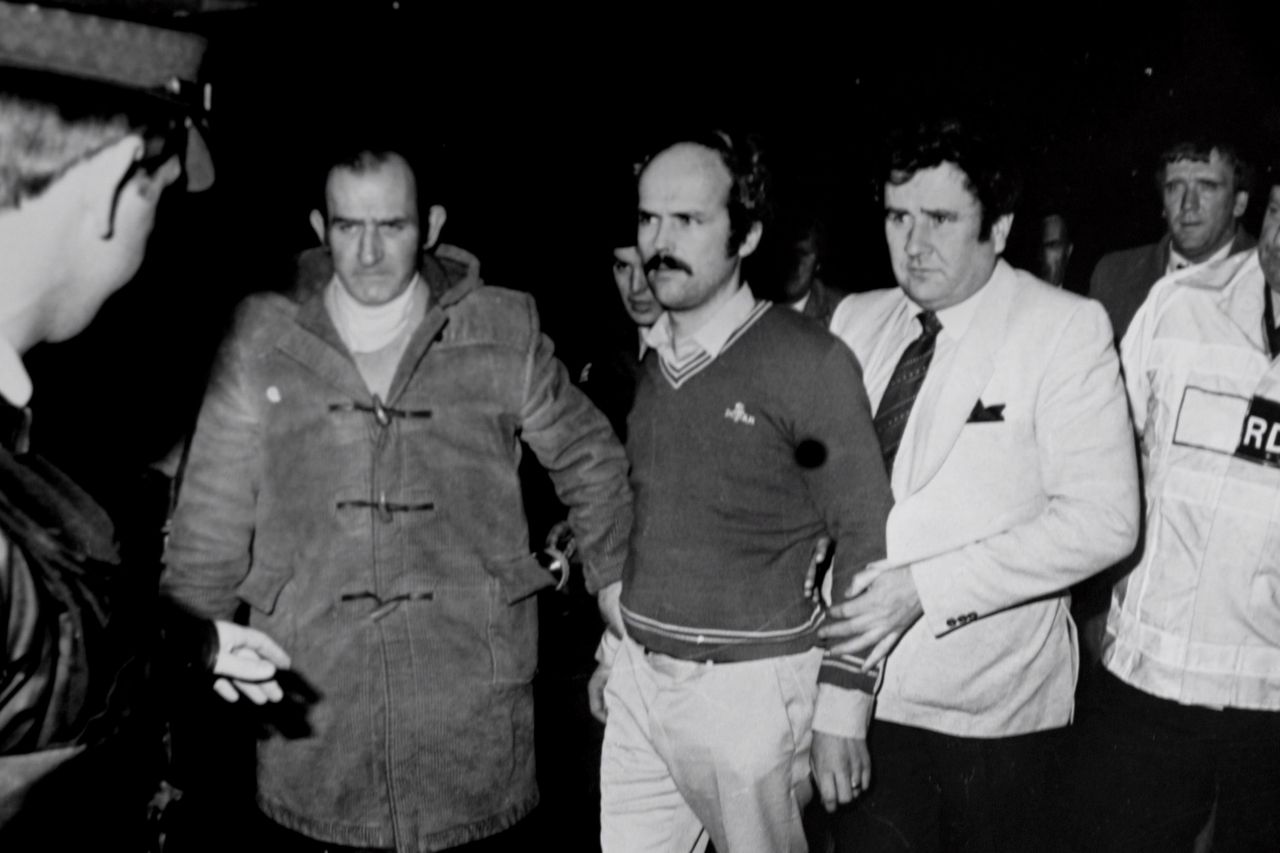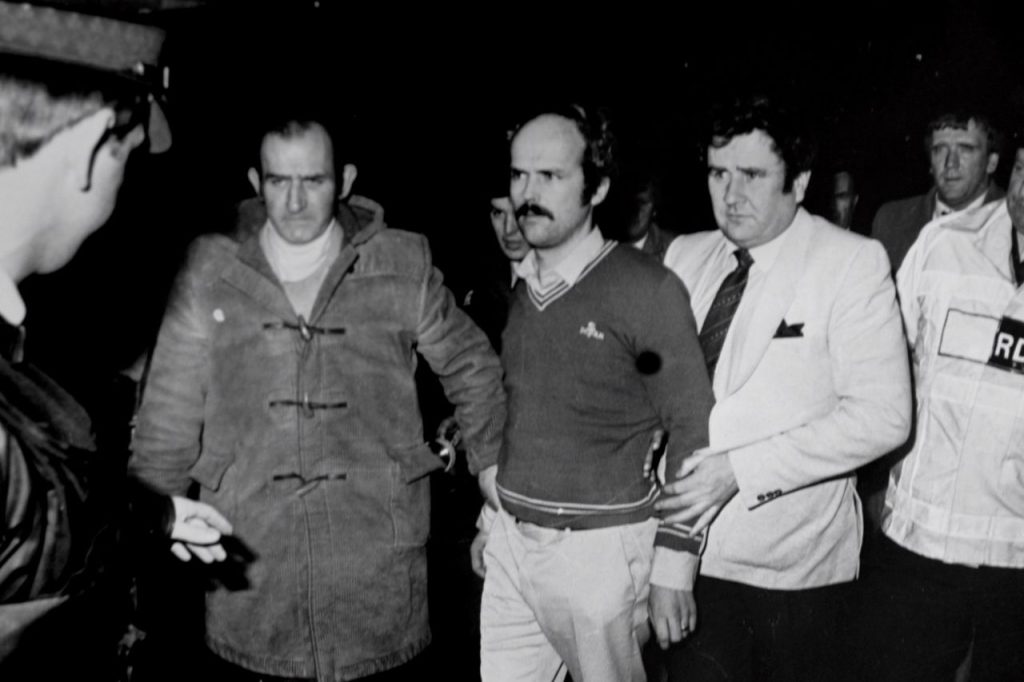Dominic ‘Mad Dog’ McGlinchey: The Fearless and Controversial INLA Leade

Dominic McGlinchey’s name is synonymous with the dark and tumultuous era of the Troubles in Northern Ireland. As a fearless and brutal leader of the Irish National Liberation Army (INLA), McGlinchey commanded respect and fear in equal measure. His life was one of defiance, shaped by poverty, radicalization, and the relentless pursuit of Irish republicanism. Known for his uncompromising tactics, McGlinchey’s legacy remains as polarizing as the conflict he was deeply entrenched in.
Background: Early Life
Dominic McGlinchey was born in 1954 in Bellaghy, County Derry, a region rife with tensions between Catholic nationalists and Protestant unionists. The second youngest of 11 children, he grew up in a working-class Catholic family steeped in republican sentiment. Poverty and political discrimination were a daily reality, shaping his worldview from an early age.
McGlinchey attended local schools but left formal education as a teenager, gravitating toward activism. By the late 1960s, as the civil rights movement in Northern Ireland gained momentum, McGlinchey became increasingly involved in the fight for equality and Irish unification.
Internment and Irish Republicanism
In the early 1970s, the British government’s policy of internment without trial targeted suspected IRA members, further radicalizing nationalist communities. McGlinchey was among those detained, spending time in Long Kesh prison. Although he denied IRA involvement at the time of his arrest, his experience in internment cemented his commitment to armed struggle.
IRA Career: A Ruthless Revolutionary
Upon his release, McGlinchey officially joined the Provisional IRA. Quickly recognized for his ferocity and tactical acumen, he rose through the ranks. McGlinchey took part in numerous operations, including attacks on British security forces and loyalist paramilitaries. His reputation for ruthlessness earned him the nickname “Mad Dog,” a moniker that reflected both his fearlessness and the brutal efficiency with which he executed IRA operations.
However, McGlinchey’s uncompromising approach often put him at odds with IRA leadership, who sought to balance revolutionary fervor with strategic considerations. Frustrated by what he saw as hesitation and inefficiency, McGlinchey left the IRA in the late 1970s.
Move to the INLA: A New Frontline
Disillusioned with the IRA, McGlinchey joined the Irish National Liberation Army (INLA), a smaller but equally radical paramilitary organization. The INLA was committed to Marxist principles alongside Irish republicanism, making it an attractive option for McGlinchey, who sought a more militant and ideologically pure approach to the conflict.
Chief of Staff: Leading the INLA
By the early 1980s, McGlinchey had become the INLA’s Chief of Staff. Under his leadership, the organization grew in both size and notoriety. McGlinchey spearheaded numerous high-profile operations, including:
1. Bombing Campaigns
McGlinchey oversaw a series of bombings targeting British infrastructure, security forces, and political symbols of unionism. These operations were designed to disrupt British control and draw international attention to the republican cause.
2. Assassinations
A key tactic during McGlinchey’s tenure was the targeted assassination of loyalist leaders and suspected informers. These actions solidified his reputation as a ruthless leader, willing to go to any lengths to achieve his objectives.
3. Cross-Border Operations
McGlinchey expanded the INLA’s activities beyond Northern Ireland, conducting operations in the Republic of Ireland and even further afield. This cross-border strategy highlighted his belief in a united Ireland and his willingness to attack symbols of British influence wherever they existed.
Family and Personal Life
Mary McGlinchey
Dominic McGlinchey’s wife, Mary McGlinchey, was deeply involved in the republican movement. Known for her own courage and activism, Mary supported her husband’s work while raising their children. Tragically, she was assassinated in front of her sons, Dominic Óg McGlinchey and Declan McGlinchey, in 1987 by unknown gunmen. Her death devastated McGlinchey and underscored the personal costs of their revolutionary lives.
Dominic McGlinchey Jr. Wife and Family
Dominic Óg McGlinchey, Dominic’s son, carried on his father’s legacy in some respects, becoming active in republican circles. However, his life was similarly marked by tragedy and loss. His wife and children have largely remained out of the spotlight, attempting to carve out normalcy amidst the shadow of their family’s past.
Declan McGlinchey
Declan McGlinchey, another of Dominic’s sons, also became associated with republican activities but reportedly sought to distance himself from the violent legacy of his parents. Like his father, Declan’s life was marked by scrutiny and hardship, a reflection of the generational impact of the Troubles.
Dominic McGlinchey’s Death: A Violent End
Dominic McGlinchey’s life came to a violent conclusion on February 10, 1994, when he was assassinated in Drogheda, County Louth. Gunned down in a telephone box while reportedly making a call, McGlinchey’s death remains shrouded in mystery. Speculation abounds about who ordered the killing, with theories ranging from rival republican factions to loyalist paramilitaries.
Dominic McGlinchey Funeral
McGlinchey’s funeral was a highly charged event, attended by republican figures and supporters who viewed him as a hero of the struggle. His death marked the end of an era for the INLA and a significant chapter in the history of the Troubles.
Marian Price and Gerry McGlinchey
The lives of prominent republican figures often intertwined. Gerry McGlinchey, Dominic’s brother, was reportedly connected to Marian Price, another key figure in the republican movement. Price, known for her involvement in IRA activities alongside her sister Dolours, shared the same fiery commitment to Irish unification that defined the McGlinchey family.
Dominic McGlinchey’s Enduring Legacy
Dominic McGlinchey’s life was a relentless pursuit of his vision for a united Ireland, characterized by both unflinching determination and devastating violence. As Chief of Staff of the INLA, he transformed the organization into a feared and formidable force, leaving a legacy that continues to inspire debate.
From his early days in the IRA to his leadership of the INLA, McGlinchey embodied the complexities of the Troubles—part hero, part villain, and always a man driven by his convictions. His story, intertwined with those of figures like Marian Price and his family, serves as a reminder of the personal and political costs of revolution.
For more insights into the lives of those who shaped Ireland’s history, visit Dolours Price: The Complex Legacy of an IRA Revolutionary and Say Nothing: A Deep Dive into the Movie and Its Impact.
Dominic McGlinchey: The Fallout of a Legacy
The life and death of Dominic McGlinchey cast a long shadow over the history of the Troubles. Revered by some as a revolutionary and reviled by others as a dangerous extremist, McGlinchey’s legacy is a microcosm of the complexities that defined Northern Ireland’s decades-long conflict. His actions, leadership, and ultimate demise reveal not only the brutal realities of the Troubles but also the enduring consequences for his family, comrades, and the communities that bore the scars of the conflict.
The Aftermath: A Family in the Crossfire
The Assassination of Mary McGlinchey
One of the most harrowing episodes in McGlinchey’s life was the assassination of his wife, Mary McGlinchey, in 1987. Mary was shot in their Dundalk home while her two young sons, Dominic Óg and Declan, witnessed the attack. The murder was particularly shocking, even in the context of the Troubles, as it targeted not just a prominent republican figure but a mother in the sanctuary of her home.
Mary McGlinchey’s funeral was a poignant and politically charged event, attended by many within the republican movement. Her death underscored the vulnerability of those involved in the conflict, where no one, not even family members, was safe from retaliation or retribution.
The Lives of Dominic Óg and Declan McGlinchey
The McGlinchey children were deeply affected by the violence that permeated their lives. Dominic Óg McGlinchey, the elder son, attempted to navigate a world that viewed his family with both reverence and suspicion. While he avoided public life for much of his youth, as an adult, Dominic Óg spoke out about his parents’ legacy and their influence on his identity.
Declan McGlinchey also struggled with the weight of his family name. Although he distanced himself from active republicanism, Declan remained a figure of interest to both supporters and critics of the republican movement. His life was marked by legal and personal struggles, a testament to the intergenerational trauma caused by the conflict.
Dominic McGlinchey Jr.’s Wife and Family
The personal lives of Dominic Óg and his family have largely remained private, though their story is inevitably shaped by the notoriety of their father and mother. Efforts to shield their children from the legacy of the Troubles reflect a desire to move beyond the cycles of violence that defined earlier generations.
Dominic McGlinchey and the INLA’s Decline
McGlinchey’s assassination in 1994 marked a turning point for the INLA, which struggled to maintain cohesion and relevance in the years following his death. Without his leadership, the organization faced internal divisions, diminishing resources, and the changing political landscape brought about by the Good Friday Agreement.
Tying McGlinchey’s Legacy to Wider Republicanism
The Price Sisters and Connections to McGlinchey
Dominic McGlinchey’s story is intertwined with other key figures of the republican movement, such as Marian Price. Marian, famously involved in the Old Bailey bombing alongside her sister Dolours Price, was married to Gerry McGlinchey, Dominic’s brother. These connections highlight the tight-knit nature of the republican struggle, where families often shared in both the sacrifices and the consequences of the conflict.
For more on Marian Price and her role in the Troubles, visit Dolours Price: The Complex Legacy of an IRA Revolutionary.
Major Operations and Their Lasting Impact
Terror or Tactics?
Under McGlinchey’s leadership, the INLA carried out operations that remain some of the most controversial of the Troubles. Bombings, assassinations, and high-profile attacks disrupted British and loyalist plans but also alienated segments of the nationalist community. McGlinchey’s strategy of uncompromising violence left a trail of devastation but also forced the British government and loyalist factions to contend with the realities of a deeply committed insurgency.
Cross-Border Legacy
McGlinchey’s operations often crossed into the Republic of Ireland, emphasizing his belief in the inseparability of Northern and Southern Ireland. These actions challenged the Republic’s government, forcing it to grapple with its relationship to the conflict in the North.
Dominic McGlinchey: A Life of Contradictions
McGlinchey’s legacy is neither straightforward nor easily categorized. For some, he remains a heroic figure of resistance, unyielding in his pursuit of Irish unification. For others, his actions represent the darkest aspects of the Troubles—a willingness to use violence at any cost, regardless of the collateral damage.
Dominic McGlinchey Funeral
McGlinchey’s funeral, like that of his wife, was a politically charged event. Attended by republican figures and watched closely by British and Irish authorities, it underscored the enduring divisions within Irish society. To his supporters, it was a moment to honor a man who had given everything for the cause. To his detractors, it was a reminder of the pain and loss inflicted during his campaign.
Conclusion: The Duality of Dominic McGlinchey
Dominic McGlinchey’s life is a study in contradictions: a man who loved his family but brought danger to their doorstep, a leader who inspired loyalty but divided opinions, and a figure whose actions embodied both the courage and the tragedy of the Troubles.
His legacy, intertwined with figures like Marian Price and his wife Mary McGlinchey, serves as a reminder of the human cost of revolution. Whether seen as a hero or a villain, McGlinchey’s life continues to provoke reflection on the lengths individuals will go to for their beliefs—and the price that is often paid.
For more in-depth analysis of the lives and legacies of key republican figures, visit Say Nothing: A Deep Dive into the Movie and Its Impact and explore the human stories behind the headlines at Secret Ireland.





4 thoughts on “Dominic ‘Mad Dog’ McGlinchey: The Fearless and Controversial INLA Leade”
Comments are closed.